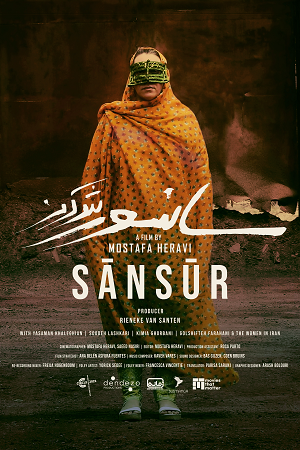
Sānsūr 2023
Distributed by Good Docs
Produced by Rieneke Van Santen
Directed by Mostafa Heravi
Streaming, 86 mins
High School - General Adult
Censorship; Discrimination; Women's Rights
Date Entered: 03/01/2024
Reviewed by Casey Mazzoli, Early Career Development Resident, Otterbein UniversitySānsūr follows six Iranian women, some no longer in Iran and some living in their home country, as they tell their stories of censorship by the government or social system. The visual aid for this theme is a traditional mask from Hormuz Island, handmade by the first woman featured. Each woman interviewed elects to wear the mask during her filming, not because it is a requirement for most of their contexts, but as a symbol in the way the creator describes it: a tool of censorship that can also draw attention to Iranian women and create a sense of honor and solidarity.
The film is honest about the complex nature of coverings and does not seem to demonize religions involving coverings (specifically Islam), but sticks to criticizing fundamentalism and government-mandated censorship. Religion is oddly absent from the film except for mentions in passing, and the film does not explicitly include the perspective of anyone who chooses to wear coverings for religious reasons or who is heavily engaged in religious activities. This could be a helpful addition to the conversation and could invite a supporting perspective on the importance of personal agency and the complex ways women grapple for or maintain agency within a religious context.
The censorship covered in the film is not strictly or primarily about clothing, though— it includes censorship in education, art, marriage, sex, politics, journalism, and career aspirations. And since the film’s definition of censorship is broader than clothing and focuses on externally imposed rules (and often laws) that supersede personal values, the absence of an explicitly religious perspective doesn’t disqualify Sānsūr as an insightful, multi-faceted film.
In addition to the woman who made the mask, the interviewees include a former teacher, a journalist, a professional athlete, a musician, and an actress. The experiences they share are difficult and often violent, including a home raid by government officials, teenage marriage and divorce, and domestic abuse. The viewers even witness one woman being aggressively questioned on the street for filming herself speaking to the camera.
The interviewees’ lives and responses to censorship are varied. Some cut their hair. Some leave relationships and move out of the country. Some remain and stay anonymous throughout the film. Some protest. They continue making art, working, caring for the people they love. By letting the women speak for themselves, the film avoids turning them into a monolith, and honor and adoration for Iran's people underpins the decrying of oppressive practices.
Overall, the film is a celebration of Iranian women and the lives they lead, as well as a work of advocacy for women's agency. It shows, in this context, the ways women must resist simply to live a life of their choosing. Each woman featured gets to share her experience authentically, and the camaraderie they express for each other is beautiful.
Awards:Best Producer, L.A. Independent Women Film Awards; Best Feature Documentary, Fierce Women Festival of Paris; Best Documentary Feature Film, Sydney Women’s International Film Festival
Published and licensed under the Creative Commons Attribution 4.0 license. Anyone can use these reviews, so long as they comply with the terms of the license.